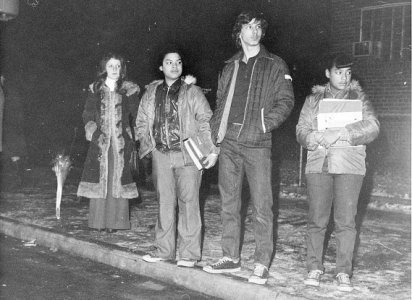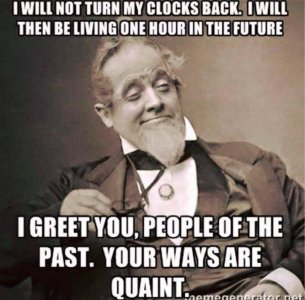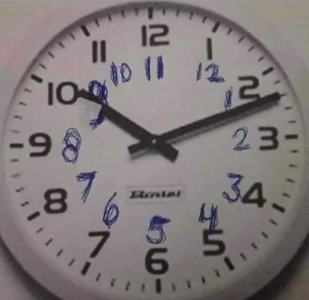You are using an out of date browser. It may not display this or other websites correctly.
You should upgrade or use an alternative browser.
You should upgrade or use an alternative browser.
Daylight saving time
- Thread starter LBrandt
- Start date
ndfinfan
★★★★★ Legendary Member
I'm a "morning person"...having more daylight in the evening does not benefit me in any way...in June/July/August I'd rather have light at 0500 to get the boat on the water before the flies come out!
i actually agree with the changing. so, i am in the minority i guess. if it stayed like it currently is, DST, on the shortest day of the year, the sun wouldn't rise in devils lake, nd until 9:23 AM. the latest sunrise in the calendar year would be 9:25 AM. everyone would be going to work and school in the absolute pitch black. i think the kids going to school is the biggest concern. sunrise would be after 9 AM from November 27 until February 2 of every year. over 2 months.
on the other hand, if we left the clocks back, the sun would rise between 4:30 AM to 5:00 AM from may 11 through july 22... also over 2 months. it would actually start to get light at like 4:00 AM. i like my mornings. but, there is no need for them to start at 4:00 AM FFS. in this case, i think we can all agree, we want the extra time in the evenings.
leaving them back all year certainly isn't an option in these parts of the country in my mind. and i think a good case can be made for why we do turn them back in the fall.
on the other hand, if we left the clocks back, the sun would rise between 4:30 AM to 5:00 AM from may 11 through july 22... also over 2 months. it would actually start to get light at like 4:00 AM. i like my mornings. but, there is no need for them to start at 4:00 AM FFS. in this case, i think we can all agree, we want the extra time in the evenings.
leaving them back all year certainly isn't an option in these parts of the country in my mind. and i think a good case can be made for why we do turn them back in the fall.
Last edited:
no
i actually agree with the changing. so, i am in the minority i guess. if it stayed like it currently is, DST, on the shortest day of the year, the sun wouldn't rise in devils lake, nd until 9:23 AM. the latest sunrise in the calendar year would be 9:25 AM. everyone would be going to work and school in the absolute pitch black. i think the kids going to school is the biggest concern. sunrise would be after 9 AM from November 27 until February 2 of every year. over 2 months.
on the other hand, if we left the clocks back, the sun would rise between 4:30 AM to 5:00 AM from may 11 through july 22... also over 2 months. it would actually start to get light at like 4:00 AM. i like my mornings. but, there is no need for them to start at 4:00 AM FFS. in this case, i think we can all agree, we want the extra time in the evenings.
leaving them back all year certainly isn't an option in these parts of the country in my mind. and i think a good case can be made for why we do turn them back in the fall.
I’m not buying the kids in the dark deal. Twilight is more dangerous IMO. I almost was smoked by a car going to class at UND because of sunrise glare. Just about S’d my P’s as the tires were squealing and it zipped by a foot in front of me.
Maddog
★★★★★ Legendary Member
[MENTION=337]guywhofishes[/MENTION]https://www1.eere.energy.gov/ba/pba/pdfs/epact_sec_110_edst_report_to_congress_2008.pdf
2. Key Findings: Changes in National Energy Consumption
Overall National Energy Consumption Findings
Using both heuristic2 and statistical analysis methods for measuring the national pattern of electricity changes, the study found:
• For the heuristic analysis, total savings of electricity during the four weeks of EDST time in 2007 was 1.3 TWh and the total primary energy saved associated with the changes inelectricity consumption was 17 TBtu.
• For the statistical analysis, total savings of electricity during the four weeks of EDST in 2007 was 1.2 TWh. This also corresponds to a total primary energy savings of 17 TBtu.The statistical variation on this result is ±40 percent (at a 95 percent level of confidence).
The electricity savings are small compared to the national total for the year, representing about 0.03 percent of the total national electricity consumption of 3,900 TWh in 2007.3 On a daily basis, the total electricity savings due to EDST was 0.46 to 0.48 percent per each day of EDST.
Electricity savings generally occurred over a period of three to five hours in the evening, offset slightly by small increases in energy consumption in several morning hours—typically the hours ending at 7:00 a.m. and 8:00 a.m. in the morning, and ending 5:00 p.m. through 9:00 p.m. in the evening. On a daily percentage basis, electricity savings were slightly greater during the March(spring) extension of DST (0.50 percent) than the November (fall) extension (0.38 percent).
Regionally, areas of the southern United States exhibited smaller impacts of EDST compared to areas of the North. The study found:
• Based on the heuristic analysis, electricity savings in the South as a percent per day were the same as in the North regions, 0.48 percent.
• Based on the statistical analysis, the average daily percent savings in electricity consumption for the North were 0.51 percent, while in the South the savings were 0.42percent.There is insufficient statistical evidence that the EDST period has had any measurable impact on motor gasoline consumption for passenger vehicles or traffic volume in 2007.
please summarize
there is way too much reading comprehension required here for me
i barely passed the 5th grade
Thanks
#guywhofishes
- Joined
- Apr 13, 2015
- Posts
- 8,444
- Likes
- 494
- Points
- 393
yes to DST -- without = Fourth of July -- sun up at 3something and down at 9, no thanks We have a short enough summer the way it is --- for those of us that have to service the 7am-6pm folks -- I will take that extra hour of sunlight at night please.
Who the hell wants to start driving home in the dark in sept Not me.
And AZ - FYI your part of the world spins faster then ours - you set earlier and rise later ---- the only reason i live here is for the long summer evenings.
Who the hell wants to start driving home in the dark in sept Not me.
And AZ - FYI your part of the world spins faster then ours - you set earlier and rise later ---- the only reason i live here is for the long summer evenings.
@guywhofishes
please summarize
there is way too much reading comprehension required here for me
i barely passed the 5th grade
Thanks
#guywhofishes
The electricity savings realized by this nonsense are small compared to the national total for the year, representing about 0.03 percent of the total national electricity consumption of 3,900 TWh in 2007.
- - - Updated - - -
0.03% is like 23 drops out of a gallon of water.
- Joined
- Apr 13, 2015
- Posts
- 8,444
- Likes
- 494
- Points
- 393
Energy crisis in the early 70s. We stayed on dst. As a kid we had mom sew reflective tape on our coats. We didn't have buses. Now days they would need to sew on pair of shorts they run out to the bus
Energy crisis in the early 70s. We stayed on dst. As a kid we had mom sew reflective tape on our coats. We didn't have buses. Now days they would need to sew on pair of shorts they run out to the bus
It was the winter of '73/'74 and we were in Rock Springs, Wy. where I worked on a chemical plant out by Little America. I think the Feds started DST early in February of '74 (not kept it all year round from the fall.) There were a lot of school children that lived on ranches out of town that took busses in to school. These kids were standing outside when it was still starlight, and they were being scared by deer, elk and even moose. The schools solved the problem and changed school start time to 9:00 am. Problem solved. DST was never moved up again in the country as far as I can remember!
- Joined
- Apr 13, 2015
- Posts
- 8,444
- Likes
- 494
- Points
- 393
What a memory. All I remember is my af parka (that was in style) having reflective tape
It was 1974, and the energy crisis was cutting into the American way of life, with odd-even gas rationing, a national speed limit and shortened Nascar races. The Emergency Daylight Saving Time Act signed by President Nixon dictated that clocks would spring forward one hour on Jan. 6 — and stay that way for almost 16 months, until April 27, 1975.
Students wait for a schoolbus at 7:35 a.m. in Astoria, Queens, during the daylight savings experiment. (Getty Images)
Students wait for a schoolbus at 7:35 a.m. in Astoria, Queens, during the daylight savings experiment. (Getty Images)
By fall, the dark mornings were apparently wearing on the American people. Proclaiming “it’s for the children” — those scholars standing at bus stops in the predawn — lawmakers threw in the towel of gloom. Year-round DST was scrapped, and on Oct. 27, clocks fell back.
It was 1974, and the energy crisis was cutting into the American way of life, with odd-even gas rationing, a national speed limit and shortened Nascar races. The Emergency Daylight Saving Time Act signed by President Nixon dictated that clocks would spring forward one hour on Jan. 6 — and stay that way for almost 16 months, until April 27, 1975.
Students wait for a schoolbus at 7:35 a.m. in Astoria, Queens, during the daylight savings experiment. (Getty Images)
Students wait for a schoolbus at 7:35 a.m. in Astoria, Queens, during the daylight savings experiment. (Getty Images)
By fall, the dark mornings were apparently wearing on the American people. Proclaiming “it’s for the children” — those scholars standing at bus stops in the predawn — lawmakers threw in the towel of gloom. Year-round DST was scrapped, and on Oct. 27, clocks fell back.
I turned my clocks back yesterday so today was a practice run. Not going to repeat what the wife told me.
- Joined
- May 15, 2015
- Posts
- 1,229
- Likes
- 179
- Points
- 238
That wasn't so bad. Was it?
Not sure as you're reply is time stamped as 6:13 but that's like 30 minutes into the future ��That wasn't so bad. Was it?
Last edited:
Similar threads
Recent Posts
-
Riddle Me This.....
- Latest: Prairie Doggin'
-
Bismarck roads and driving
- Latest: Fester
-
Israel
- Latest: svnmag
-
I Love This Bar (NDA)
- Latest: svnmag
-
Answer me this
- Latest: svnmag
-
NFL News (Vikings)
- Latest: Obi-Wan
-
Quiet Pellet Gun
- Latest: 3Roosters
-
More CWD NE ND
- Latest: Fritz the Cat
-
Coffee and sweet beaver
- Latest: Maddog
-
Presidents who added the most
- Latest: grumster
-
Drotto adjustment?
- Latest: Fester
-
Check your bags boys
- Latest: svnmag
-
Tractors
- Latest: Davey Crockett
-
Spring snows 24
- Latest: 870XPRS
-
Tract Optics
- Latest: rodcontrol
-
Any Birders here?
- Latest: svnmag
-
Prairie ghost
- Latest: johnr
-
A good movie
- Latest: gillraker
-
Skinwalker Ranch
- Latest: svnmag
Friends of NDA
Top Posters of the Month
-
This month: 197
-
- Posts
- 975
-
- Likes
- 876
-
-
This month: 119
-
- Posts
- 2,017
-
- Likes
- 838
-
-
This month: 95
-
- Posts
- 1,409
-
- Likes
- 1,007
-
-
This month: 88
-
- Posts
- 521
-
- Likes
- 206
-



